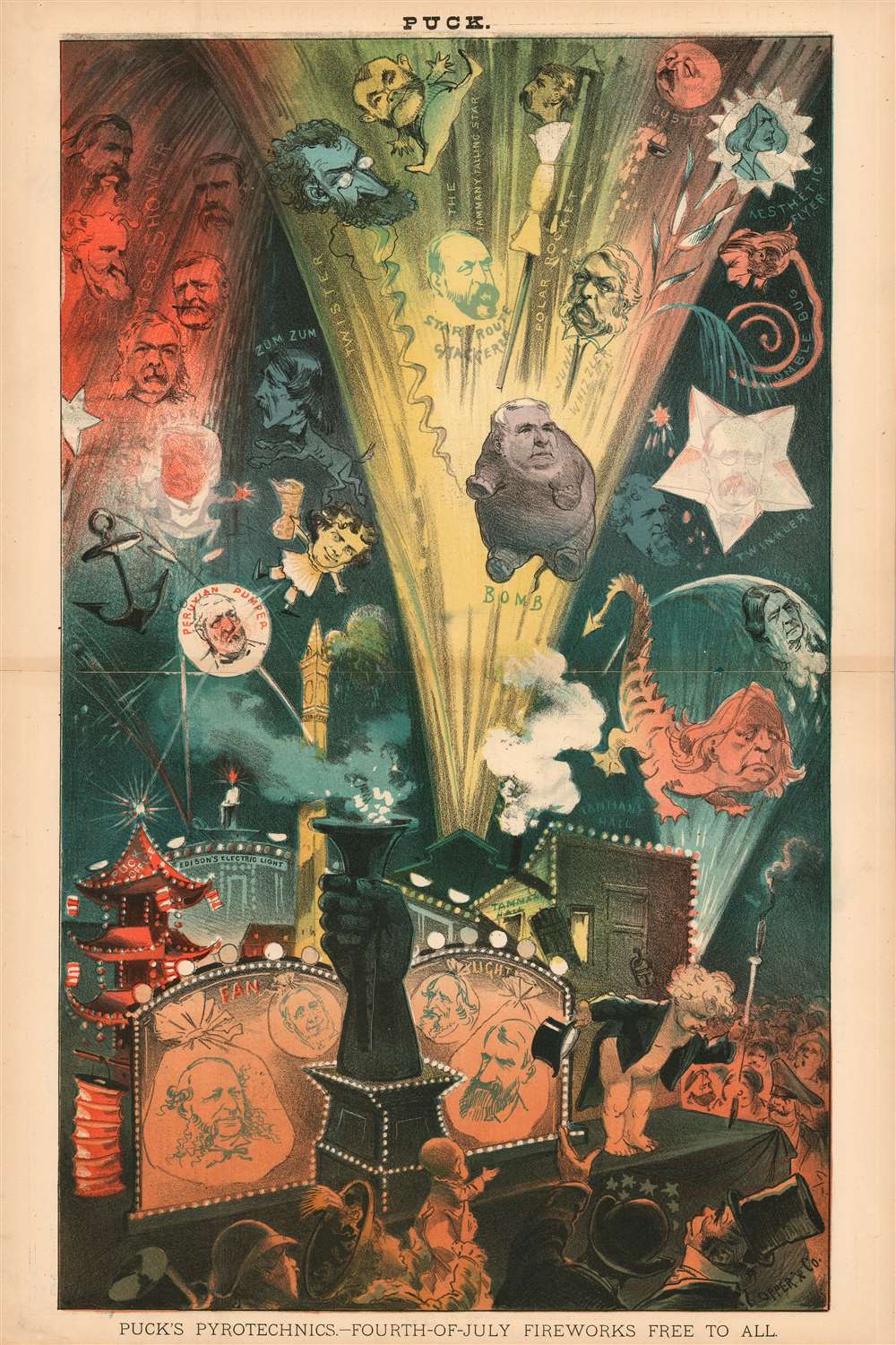1882 Opper Satirical Cartoon Lampooning Gilded Age Republican Corruption
Pyrotechnics-puck-1882
Title
1882 (undated) 13 x 19 in (33.02 x 48.26 cm)
Description
The Setting
Behind the stage and beneath the fireworks display is a fanciful skyline: The Puck building is portrayed as a festively-lit Chinese pagoda. Thomas Edison's new Pearl Street generating station is shown - with a gigantic candle set upon it. (The station had just been established in 1882, and would not actually go live until September of that year.) Tammany Hall (one of Opper's favorite targets) appears as well - with a prominent padlock on its unlit door.The Fireworks
Each of Puck's fireworks are named, and refer to recent scandals concerning the unnamed but well-known figures pictured within the blasts. Many of these revolve around the political machinations leading up to the 1880 Republican election of James Garfield, the fallout from his assassination, and widespread accusations of Republican corruption overall.Chicago Shower
A fringe theory of the day was that the 1881 Chicago Fire had been started by a meteor shower: the shower of misfortune in this case being the fall in the 1880 Republican National Convention of the stalwarts (chiefly Ulysses S. Grant, Chester Arthur, Roscoe Conklin, John Logan, and James Donald Cameron, pictured here. The stalwarts, supporters of Grant, had been defeated by Garfield, Following his 1881 assassination of President Garfield, Charles Guiteau loudly declared himself a stalwart, thus obliquely implicating Garfield's former rivals.Tumbler
Governor Samuel J. Tilden of New York, in 1880 the presumptive Democratic candidate in 1880 presidential election - though he would fall from from favor, being beaten by Hancock - who would be in turn defeated by Garfield.Peruvian Pumper
a.k.a.. Garfield's Secretary of State, James Gillespie Blaine, accused of having ulterior financial motives in his support of Peru during his diplomatic efforts during the War of the Pacific.Star Route Staggerer
Stephen W. Dorsey, Secretary of the Republican National Committee and implicatee in the 'The Star Route scandal,' a scheme whereby United States postal officials received bribes in exchange for awarding postal delivery contracts.The Beecher/Tilton Scandal
A sex scandal! The Abolitionist Henry Ward Beecher is depicted as a great dragon - an allusion to his doomed fight against the Chinese Exclusion Act, which passed that year. He is overshadowed by 'Aurora', the suffragist Elizabeth Richards Tilton, whose adulterous relationship with Beecher twelve years prior still dogged the politician.Polar Rocket
The flamboyant James Gordon Bennett is pictured, strapped to a 'Polar Rocket' - an allusion to his financial backing of the ill-starred 1879–1881 Jeannette expedition to the Arctic, whose tragic denouement had just unfolded.Tammany Falling Star
at top center witness 'Honest' John Kelly, a boss of Tammany Hall who had just lost his position as city comptroller and was two years from retirement. (Opper never passed up an opportunity to swipe at Tammany Hall.)Junk Whizzler
George Robeson, a Republican Representative for New Jersey who had been in Puck's sights for his allocation of a massive surplus to the Navy.Twister
More corruption: Carl Schurz, who had been a controversial leader of the notoriously corrupt Indian Affairs Office, but whose appearance here may be due to his 1881-1883 management of the New York Evening Post.Chromolithography
Chromolithography is a color lithographic technique developed in the mid-19th century. The process involved using multiple lithographic stones, one for each color, to yield a rich composite effect. Oftentimes, the process would start with a black basecoat upon which subsequent colors were layered. Some chromolithographs used 30 or more separate lithographic stones to achieve the desired effect. Chromolithograph color could also be effectively blended for even more dramatic effects. The process became extremely popular in the late 19th and early 20th centuries, when it emerged as the dominate method of color printing. The vivid color chromolithography produced made it exceptionally effective for advertising and propaganda imagery.Publication History and Census
Drawn by Frederick Burr Opper for Puck Magazine. OCLC shows only one example of this held separately in the Library of Congress. We see no other examples in dealers' catalogues or auction records.Cartographer
Frederick Burr Opper (January 2, 1857 – August 28, 1937) was an American artist and pioneer of the American newspaper comic strip, best known for his successful Happy Hooligan. His oeuvre encompassed humorous magazine cartoons, covers, political cartoons and comic strips spanning sixty years. The eldest of three children born to Austrian-American immigrants Lewis and Aurelia Burr Oppers in Madison, Ohio, he dropped out of school at fourteen to work as a printer's apprentice at the local Madison Gazette. Two years later he moved to New York City where he worked day jobs while continuing to draw. He studied briefly at Cooper Union, and worked briefly under illustrator Frank Beard. Opper's first cartoon was published in Wild Oats in 1876, after which he received regular work from Scribner’s Monthly and St. Nicholas Magazine. He worked steadily for Leslie's Weekly (1877 to 1880) but found a home employer with Puck Magazine for 18 years, drawing spot illustrations, color centerfold spreads, and covers. With Puck, Opper blossomed as a satirist, skewering newspaper moguls, politicians, and industrialists while championing 'Mr. Common Man.' His work spread to newspapers around the country, and in numerous books. A professional cartoonist, he painted as a hobby. More by this mapmaker...

